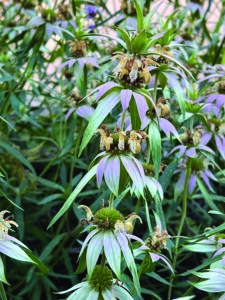
“BeeBop’ is a compact and early flowering selection of dotted beebalm and when in bloom provides for hummingbirds, butterflies and other pollinators. (Photo by Ginny Rosenkranz)
Monarda punctata, or “BeeBop,” is also known as dotted beebalm and will thrive on our Eastern Shore in sandy soils with moisture and full sun.
Once established, dotted beebalm becomes more drought tolerant, but will always flower better and are less susceptible to powdery mildew with some moisture.
“BeeBop” is a compact and early flowering selection of dotted beebalm and when in bloom provides a feast for hummingbirds, butterflies and other wonderful pollinators.
The square stems rise 1 1/2 feet tall and wide, spreading slowly by runners to form clumps.
The aromatic leaves have a toothed margin and grow up to 3 inches long, and can be used in teas.
The beautiful and unusual flowers are the main focus with the showy blooms stacking on top of each other.
Each flower is formed of rosettes with small tubular shaped yellow flowers perched on top of large pink-purple spotted bracts arranged in whorls around the square stems, creating a tower of blooms that flower from July through September.
The flowers are beautiful in the garden and also make excellent cut flowers.
Cutting the spent flowers improves the look of the plants and can encourage even more flowering.
Deer and rabbits usually leave ‘BeeBop’ alone, probably because of the delightfully fragrant foliage.
These slow spreading plants look wonderful in butterfly, pollinator, cottage and meadow gardens, and can be planted into containers to add height to the gardens.
(Editor’s Note: Ginny Rosenkranz is a commercial horticulture specialist with the University of Maryland Extension.)



